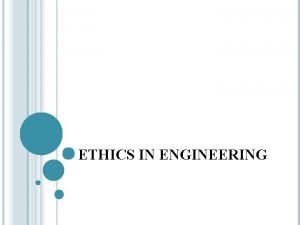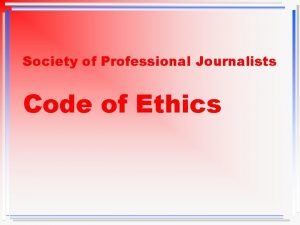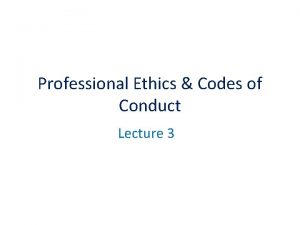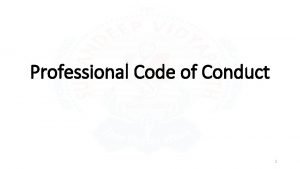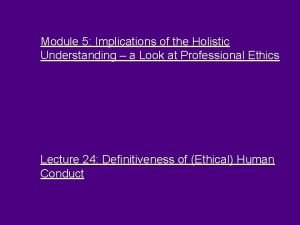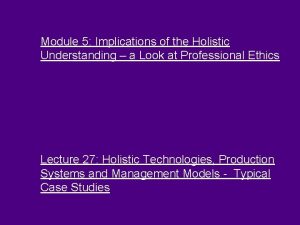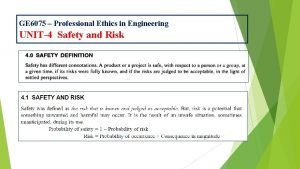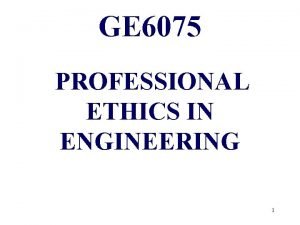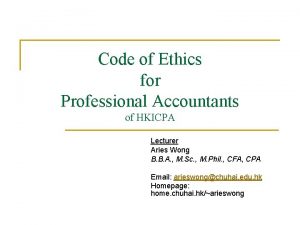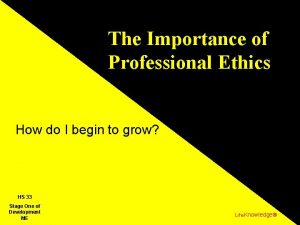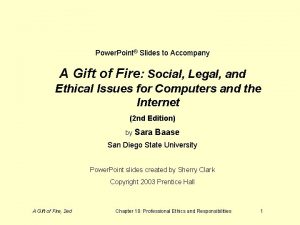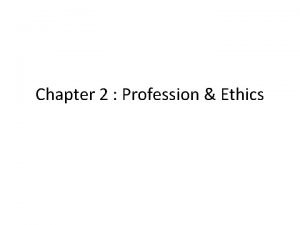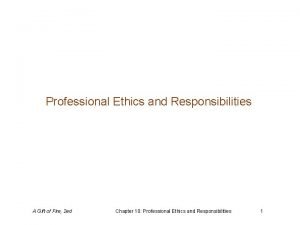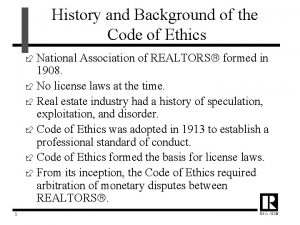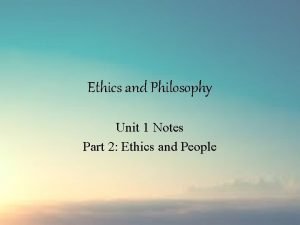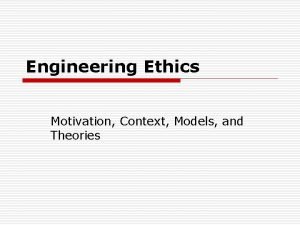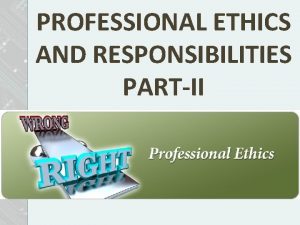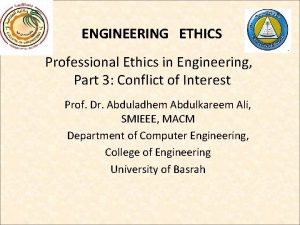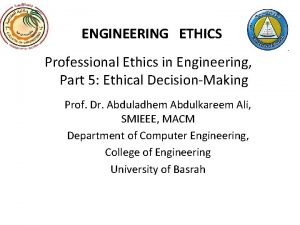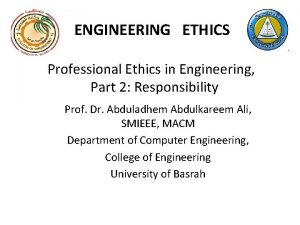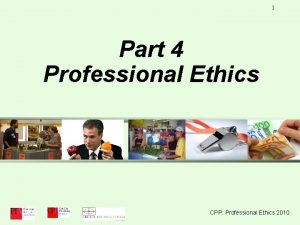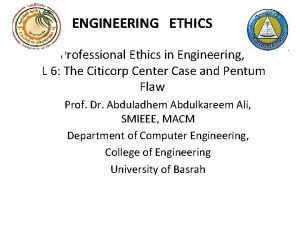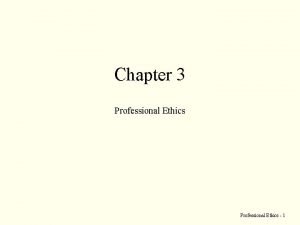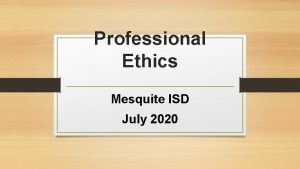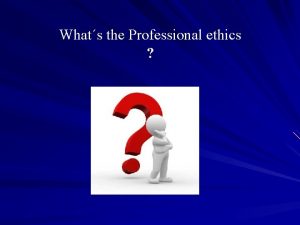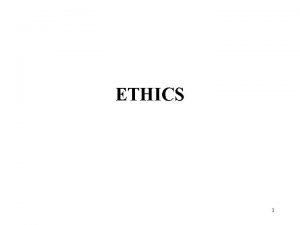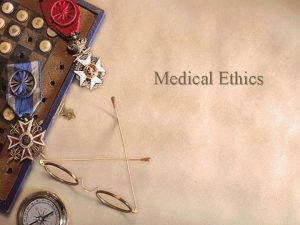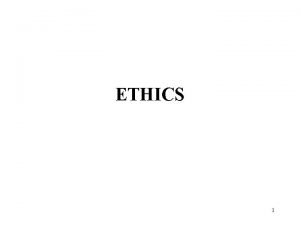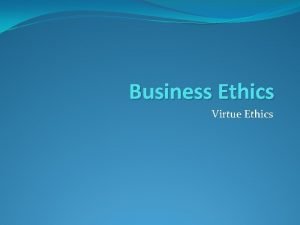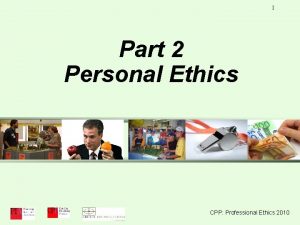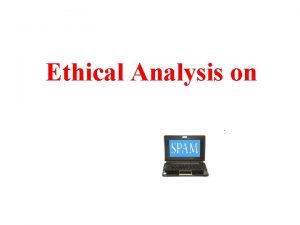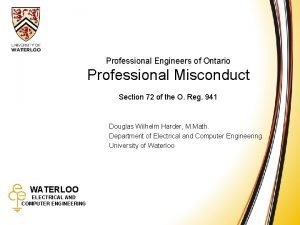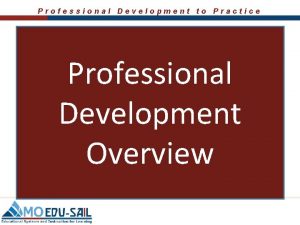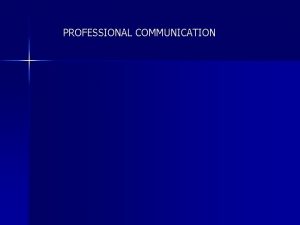ENGINEERING ETHICS Professional Ethics in Engineering Part 5
























- Slides: 24

ENGINEERING ETHICS Professional Ethics in Engineering, Part 5: Framing the Problem Prof. Dr. Abduladhem Abdulkareem Ali, SMIEEE, MACM Department of Computer Engineering, College of Engineering University of Basrah

Framing the Problem • To a large extent, moral disagreement occurs against the background of widespread moral agreement. • Disagreement about moral matters is often more a matter of disagreement about facts than moral values. • Disagreement is also sometimes about conceptual matters—what concepts mean and whether they apply in particular circumstances. • Much of the content of engineering codes of ethics is based on the application of ideas of our common morality to the context of engineering practice. • Two general moral perspectives that can be helpful in framing moral problems in engineering are the utilitarian ideal of promoting the greatest good and that of respect for persons.

OSHA and U. S. Supreme Court air exposure to benzene • IN 1977, The Occupational Safety and Health Administration (OSHA) issued an emergency temporary standard requiring that the level of air exposure to benzene in the workplace not exceed 1 part per million(ppm). • This was a departure from then current standard of 10 ppm. OSHA wanted to make this change permanent because of a recent report to the National Institutes of Health of links between leukemia deaths and exposure to benzene.

• Reported deaths were in workplaces with benzene exposure levels above 10 ppm, and there were no animal or human test data for lower levels of exposure. • OSHA advocated changing the standard to the lowest level that can be easily monitored (1 ppm). • July 2, 1980, the U. S. Supreme Court ruled that OSHA’s proposed 1 ppm standard was too strict. The law, said the Court, does not ‘‘give OSHA the unbridled discretion to adopt standards designed to create absolutely risk-free workplaces regardless of the costs. ’’

• Petrochemical Industry: total of 496 employees exposed to benzene, only 53 percent were exposed to levels between 1 and 5 ppm, and 7 percent were exposed to between 5 and 10 ppm. 5 But most of the scientific evidence involved exposure well above 10 ppm. • Court held that a safe work environment need not be risk-free. • OSHA officials objected to shifting to them the burden of proof that chemicals such as benzene are dangerous,

• The conflicting approaches of OSHA and the Supreme Court illustrate legal and possibly moral disagreement. • OSHA officials were concerned about protecting workers, despite the heavy costs in doing so. • The Supreme Court justices apparently believed that OSHA officials had not sufficiently taken into account the small number of workers affected, the technological problems involved in implementing the new regulations, and the impact of regulations on employers and the economy. • we usually experience moral disagreement and controversy within a context of agreement.

DETERMINING THE FACTS • We must begin by considering what those facts are. In any given case, many facts will be obvious to all. • Sometimes people come to different moral conclusions because they do not view the facts in the same way. • Sometimes they disagree about the relevance or relative importance of certain facts.

1. Often, moral disagreements turn out to be disagreements over the relevant facts. 2. Factual issues are sometimes very difficult to resolve. • 3. Once the factual issues are clearly isolated, disagreement can re-emerge on another and often more clearly defined level.

Agreeing and Disagreeing • Known and Unknown Facts: Even a single unknown relevant fact might make a crucial difference • Weighing the Importance of Facts: One engineer thing adding more safety save lives other increase cost. Burden should be shifted to consumer other protect consumers from their own negligence.

CLARIFYING CONCEPTS • get as clear as we can about the meanings of key terms. For example, ‘‘public health, safety, and welfare, ’’ ‘‘conflict of interest, ’’ ‘‘bribery, ’’ ‘‘extortion, ’’ ‘‘confidentiality, ’’ ‘‘trade secret, ’’ and ‘‘loyalty’’ are key terms for ethics in engineering.

CLARIFYING CONCEPTS Case ‘‘dishonesty’’ • Suppose a firm signs a contract with a customer that specifies that all parts of the product will be made in the United States, but the product has a special 1=4 -inch staple hidden from view that was made in England. Is the firm dishonest if it does not tell its customer about this staple?

Clear-cut case of dishonesty • customer asking, ‘‘Is there anything in this product that wasn’t made in the U. S. A. ? ’’ • Firm’s representative, answers ‘‘No’’ Unclear case • customer asks, ‘‘Does this product have any parts not made in the U. S. A. ? ’’ • Firm’s representative, answers ‘‘No’’

Customer Opinion: • ‘‘After all, that little staple isn’t a part; it simply holds parts together. ’’ • Of course, this raises the question of what is meant by ‘‘part. ’’ • given the contract’s specifications, honesty in this case would seem to call for full disclosure. Then the customer can decide whether the English staple is acceptable. • Better yet would be for the firm to contact the customer before using the staple, explaining why it is needed and asking whether using it would be acceptable.

APPLICATION ISSUES • Even when we are reasonably clear about what our concepts mean, disagreement about their applications • Disagree whether certain concepts apply in particular circumstances. • What we mean by ‘‘safe’’ and another to determine whether a given situation should count as safe, considering the definition. • In many situations, a clear definition of a term can make its application unproblematic.

COMMON GROUND: Common Morality • begin an analysis with two questions: What are the relevant facts? What are the relevant kinds of ethical considerations? • For example, conflict of interest may be an ethically important concept to consider—but only when the facts of a case suggest that there might actually be a conflict of interest.

Common Morality • Problem: Many of us will appeal to our religious commitments, others to more secular commitments. Nevertheless, there is a surprising degree of agreement about the content of common morality. • people do differ to some extent in their moral beliefs because of such factors as family background and religious upbringing, but most of these differences occur with respect to beliefs about specific practices

GENERAL PRINCIPLES • Common morality is too loosely structured. • Appeals: 1 - Utilitarian ideal of maximizing good consequences and minimizing bad consequences. 2 - Ideal of respect for persons.

UTILITARIAN THINKING ‘‘The greatest good for the greatest number. ’’ • Three prominent ways: One: The Cost–Benefit Approach: The course of action that produces the greatest benefit relative to cost is the one that should be chosen. sometimes referred to as risk–benefit analysis 1. Assess the available options. 2. Assess the costs 3. Make the decision • cost–benefit analysis might seem to justify many practices in the past that we have good reason to believe were morally wrong. In the 19 th century, many people opposed child labour laws, arguing that they would lead to economic inefficiencies.

• Two: The Act Utilitarian Approach : • Maximize good consequences. 1. Identify the available options in this situation. 2. Determine the appropriate audience for the options, keeping in mind the problems in determining the audience. 3. Bear in mind that whatever option is selected, it sets an example for others, and anyone else in relevantly similar circumstances would be justified in making a similar selection. 4. Decide which available option is likely to bring about the greatest good for the appropriate audience, taking into account harms as well as benefits.

Three: The Rule Utilitarian Approach • Resolved by having commonly accepted rules that enable us to predict reliably what others will do. • The rule utilitarian approach to this sort of problem is to propose rules that are justified by their utility. When such rules are reasonably well understood and generally accepted, there advantages for individuals using rules as a guide to action rather than attempting directly to calculate the likely consequences of the various alternative courses of actions in each situation.

RESPECT FOR PERSONS • The moral standard of the ethics of respect for persons is as follows: Those actions or rules are right that regard each person as worthy of respect as a moral agent. • The Golden Rule Approach: • ‘‘What if everyone did that? ’’ • ‘‘Why should you make an exception of yourself ? ’’ • judgment should not change simply because the roles are reversed.

• Unfortunately, this tactic does not resolve all the problems. • Suppose I am an engineer who supervises other engineers and I find that I must dismiss one of my supervisees because he is lazy and unproductive. • The Self-Defeating Approach • Whether I would be able to perform the action in question if everyone else performed the same action in the same or similar circumstances: If everyone else did what I am doing, would this undermine my own ability to do the same thing?

The Rights Approach • A right may be understood as an entitlement to act or to have another individual act in a certain way. • regarded as prohibiting certain infringements of our moral agency by others. • The problem of conflicting rights requires that we prioritize rights, giving greater importance to some than to others.

1. Identify the basic obligations, values, and interests at stake, noting any conflicts. 2. Analyze the action or rule to determine what options are available and what rights are at stake. 3. Determine the audience of the action or rule (those whose rights would be affected). 4. Evaluate the seriousness of the rights infringements that would occur with each option, taking into account both the tier level of rights and the number of violations or infringements involved. 5. Make a choice that seems likely to produce the least serious rights infringements
 Professional ethics in engineering notes
Professional ethics in engineering notes Professional ethics in engineering
Professional ethics in engineering Texas board of professional engineers roster
Texas board of professional engineers roster Code of ethics of the society of professional journalists
Code of ethics of the society of professional journalists 8 general moral imperatives
8 general moral imperatives Code of conduct professional ethics
Code of conduct professional ethics Definitiveness of ethical human conduct
Definitiveness of ethical human conduct Case studies of typical holistic technologies
Case studies of typical holistic technologies Ratesetter legal finance
Ratesetter legal finance Legal ethical and professional aspects of security
Legal ethical and professional aspects of security Ge 6075
Ge 6075 What is service learning in professional ethics
What is service learning in professional ethics Resolution 435 code of ethics
Resolution 435 code of ethics Code of ethics for professional accountants
Code of ethics for professional accountants Professional ethics presentation
Professional ethics presentation Challenger ethics case study
Challenger ethics case study Importance of professional ethics
Importance of professional ethics Cips code of ethics and professional conduct
Cips code of ethics and professional conduct Characteristics of a profession
Characteristics of a profession Gift of fire
Gift of fire Valuing time in professional ethics
Valuing time in professional ethics History of professional ethics
History of professional ethics Professional ethics decision-filter
Professional ethics decision-filter Professional ethics unit 1 notes
Professional ethics unit 1 notes Asme code of ethics
Asme code of ethics

